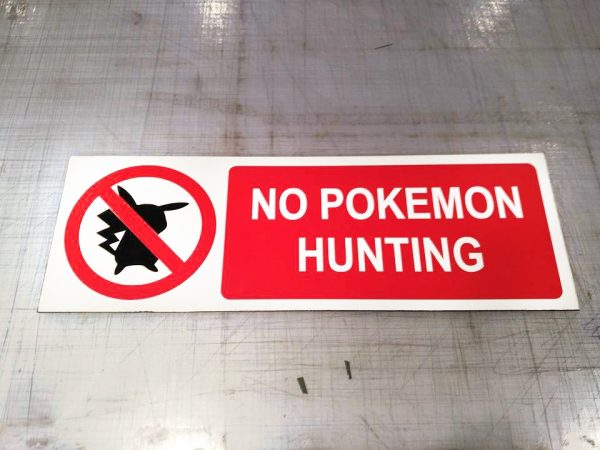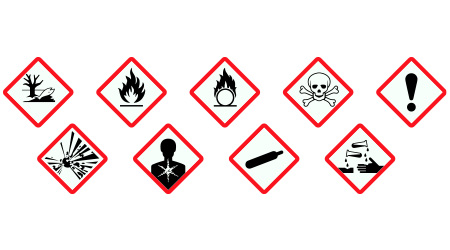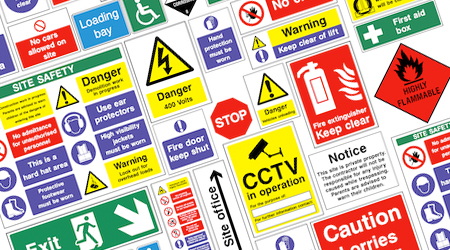NO POKEMON HUNTING SIGN

funny signs, birthday banner printing, custom room signs
A few months ago, we would never dream of a sign called “No Pokemon Hunting”, but there it is. There have been incidents all over the world, and two people died while hunting Pokemon.
Funny enough, in the hope of finding Pokemon or finishing a task, trespassers increased.
You can see the safety sign a respectful client of ours requested today in the photo, so it looks dangerous.
Rumour has it that Rihanna Makes It Very Clear: No Pokémon Go Hunting at Her Shows.
2024 Editors Update:
Pokémon Go: From a Global Phenomenon to a Forgotten Trend
When Pokémon Go launched in July 2016, it became an instant sensation, capturing the imagination of millions across the globe. Created by Niantic, Inc., the augmented reality (AR) mobile game merged the digital world with reality in a way that had never been done before. Players, armed with their smartphones, were encouraged to “catch” virtual Pokémon creatures in the real world by walking to various locations. While its appeal was universal, its sudden rise in popularity also brought unexpected consequences, including accidents, safety concerns, and ultimately, a swift decline in public interest. Crazy enough; Companies started to install “No Pokemon Hunting” sign. Let’s dive into how Pokémon Go went from a viral trend to a largely forgotten part of gaming history.
How Pokémon Go Captured the World
Upon its release, Pokémon Go attracted millions of players from all age groups. The game’s premise was simple yet groundbreaking: players used their smartphone’s GPS to explore real-world locations in search of Pokémon, which would appear on their screens using augmented reality. Major landmarks became PokéStops and Gyms—key places where players could collect items or battle their Pokémon.
The nostalgia of the Pokémon franchise, which had been popular since the 1990s, combined with this unique gameplay, made it instantly appealing. Pokémon Go was more than just a game—it was a social experience that got people outside, exercising, and interacting with other players in public spaces. Parks, shopping centres, and even remote rural areas suddenly saw an influx of people walking around with their heads buried in their phones, chasing virtual creatures.
Accidents and Incidents: A Dangerous Game?
As the initial excitement of Pokémon Go swept across the globe, it became clear that the game’s design—encouraging users to move through real-world spaces while staring at their screens—came with significant risks. News stories began to emerge of players getting into accidents because they were too engrossed in the game to pay attention to their surroundings.
For instance, there were reports of players walking into traffic, falling into ditches, and even trespassing onto private property while attempting to catch Pokémon. In more severe cases, some individuals were involved in car accidentsbecause they played the game while driving. A study published in JAMA Internal Medicine in 2016 estimated that Pokémon Go may have contributed to an increase in traffic accidents, with some resulting in fatalities.
One widely reported incident involved two men in California who, while trying to catch Pokémon, fell off a cliff. Other cases involved players being injured while crossing busy streets without paying attention or getting into altercations at PokéStops in inappropriate locations, such as cemeteries or police stations.
Warnings and Safety Signs: Adapting to the Craze, “No Pokemon Hunting” sign
As the game’s popularity exploded, authorities began to implement warnings and signage in an attempt to mitigate the risks. Local governments, transportation departments, and even businesses put up signs warning players to “play safely”and “look up while walking”. Parks and museums installed notices reminding players to stay on designated paths and respect property boundaries.
Several cities around the world enacted stricter regulations to ensure public safety. For example, Japan’s government issued safety guidelines that included warnings about playing near traffic, cliffs, and other hazardous locations. Some places even implemented temporary restrictions on playing the game in specific areas, such as war memorials, private estates, and religious sites, where the presence of large groups of players was disruptive.
Despite these efforts, accidents continued to happen. Some players ignored warnings, believing that the excitement of catching a rare Pokémon outweighed the potential danger.
Pokémon Go’s Rapid Decline
The initial hype around Pokémon Go was staggering, with the game being downloaded over 500 million times in its first few months. However, as is often the case with viral trends, its popularity waned almost as quickly as it had risen.
A key reason for this decline was that the game’s novelty wore off. After a few months of excitement, players began to lose interest, with some citing the lack of new features, repetitive gameplay, and technical glitches as reasons for quitting. While Niantic introduced updates and special events in an attempt to keep the player base engaged, many had already moved on to other forms of entertainment.
In just a year, Pokémon Go had gone from being a global obsession to a distant memory for most people. Social media, which had once been filled with screenshots and success stories, gradually shifted to the next big thing, leaving Pokémon Go behind.
A Cultural Moment, Quickly Forgotten
Today, Pokémon Go still has a dedicated community of players, but it no longer commands the public attention it once did. Its meteoric rise and equally swift fall demonstrate the fleeting nature of many viral trends. While the game had an unprecedented impact on mobile gaming, augmented reality, and even public health (by encouraging exercise), it now sits as a reminder of how quickly cultural moments can come and go. There are no visible “No Pokemon Hunting” signs around anymore.
For many, the Pokémon Go craze is already a faint memory—something that was once exciting but has since faded from everyday life. While the game still exists and has its devoted fans, it no longer holds the place of prominence it did when it first took the world by storm in 2016.
A Lesson in Caution
Pokémon Go was more than just a mobile game—it was a cultural phenomenon that briefly dominated public consciousness. It encouraged people to explore the outdoors and interact with others, but it also came with significant risks. From accidents to safety warnings by installing “No pokemon hunting” signs, the game’s legacy includes important lessons about the balance between innovation and safety. While Pokémon Go has been largely forgotten by the mainstream, it remains an example of how quickly a trend can rise—and just as quickly fall—while leaving lasting impacts on society.
Disclaimer:
The information provided in this blog is for general informational purposes only. While every effort has been made to ensure the accuracy of the content, EU Signs Ltd does not guarantee the accuracy, completeness, or reliability of the information presented. The blog discusses accidents and incidents related to the Pokémon Go mobile game, but these anecdotes are based on publicly reported events and are not meant to be exhaustive or conclusive.
Readers are advised to use caution when engaging with augmented reality games, particularly in public spaces, and to always adhere to local laws and safety guidelines. EU Signs Ltd is not liable for any actions taken based on the content of this blog. Please consult official sources for the most accurate and up-to-date information on augmented reality gaming, safety protocols, and local regulations.
Always use AR games responsibly and in accordance with your surroundings.
Other articles you might be interested:
Related Products from our online shop:







Add comment
You must be logged in to post a comment.